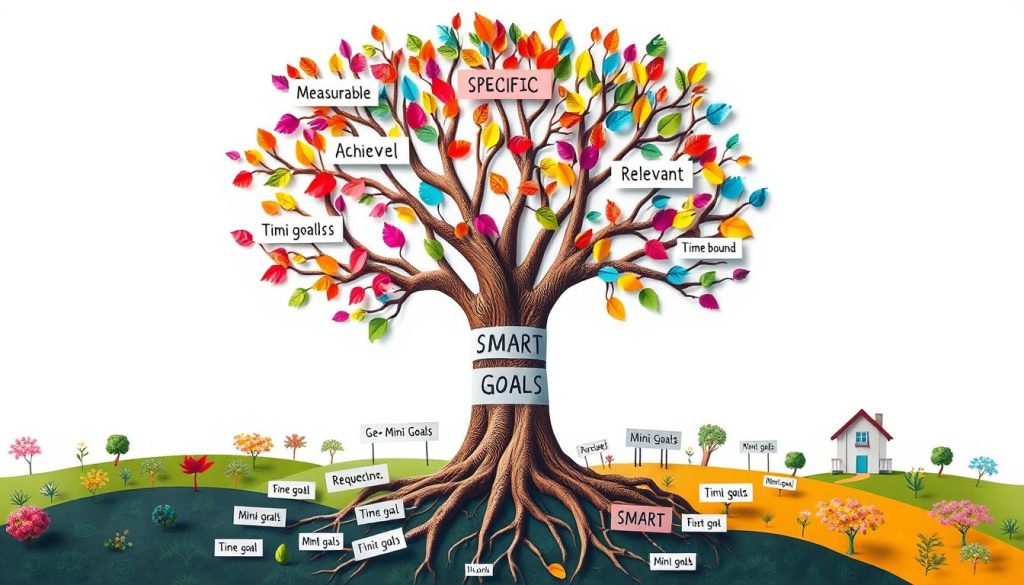Achieve Your Dreams with Goal Setting Strategies for Success
Setting goals is key to making dreams come true. Sadly, 80 percent of people give up on their New Year’s resolutions by February. This shows how important it is to have good goal setting strategies.
Goal setting is more than just listing things you want. It’s about seeing your future and planning how to get there. I’ll share goal setting techniques that have worked for me in this article.
I once aimed to hire a full-time assistant. I not only reached my goal but also celebrated each step. This taught me the value of setting realistic goals. Friends and family have seen the benefits too.
Staying committed and bold in my dreams has changed my life. Let’s explore goal setting together. I want to help you unlock your potential and achieve success.
Understanding Goal Setting
Goal setting is key to personal growth. It’s not just dreaming big; it’s about setting clear goals. Research shows that specific goals boost motivation and effort.
Writing down my goals helps me stay on track. Having someone to check in with makes it even better. This way, I’m more likely to succeed.
Setting specific goals is crucial. It gives me a clear path and keeps me motivated. This approach helps me see the bigger picture and find purpose in my work.

Clear goals guide my actions and keep me focused. Using strategies like habit stacking keeps me on track. Goal setting pushes me to do my best, not just the bare minimum.
What Are Goal Setting Strategies?
Goal setting strategies are ways to set and chase after your dreams. They help you make clear, reachable goals. Using the SMART criteria, you can make goals that are specific, measurable, achievable, realistic, and time-bound.
For instance, instead of saying “improve customer satisfaction,” you could aim to “increase it from 75% to 85% in six months.” This makes your goal clear and lets you track your progress.
Breaking down big goals into smaller steps is also helpful. This way, you can make steady progress towards your big dreams. Using the Eisenhower matrix helps you focus on the most important tasks first.

Using different goal setting methods, like the WOOP method, makes your goals more real and achievable. It helps you stay committed and increases your chances of success. Whether you use BHAGs or the Pomodoro Technique, these strategies keep you motivated.
By using many goal setting strategies, you can find clear paths to success. This also builds your resilience and determination on your journey.
Why Is Goal Setting Important?
Goal setting is crucial in my life. It gives me direction and turns dreams into doable plans. This clarity boosts my motivation, making sure my work matches my values. By setting specific goals, I can sort out my tasks better, leading to smarter choices in work and life.

Reaching goals, big or small, motivates me to keep going. I use SMART goals to boost my success chances. Outlining steps after setting a goal keeps me focused and confident.
Micro-goals help me stay excited. They let me celebrate small wins, keeping my motivation up. Regular checks on my progress and goal tweaks keep me on track. Studies show that 90% of specific goals lead to better performance, proving goal setting’s power.
But, I know I’m part of a bigger group: 84% of people don’t set goals. This fact pushes me to set my own goals. It helps me grow personally and fight procrastination. Goal setting is key to my long-term success and happiness.
How Goal Setting Boosts Confidence and Motivation
Setting goals is key to boosting confidence and motivation. Every goal I reach, big or small, builds my self-belief. This keeps me believing in myself and ready for bigger challenges.
Reaching short-term goals makes me feel accomplished. This feeling keeps me moving towards my long-term dreams.
Using the SMART framework helps me set clear goals. This makes me more motivated and focused on my growth. Time-bound goals help me stay on track and use my time well.
Tracking my progress through regular reviews is rewarding. It boosts my confidence and motivates me to aim higher. Looking back at why I set goals keeps me driven. Overcoming hurdles helps me learn and grow, finding new ways to succeed.

Key Elements of Effective Goal Setting
Effective goal setting is about understanding and using key elements. These elements help me stay focused and motivated on my journey. They are the foundation for lasting success.
Clarity is a critical element of goal setting. Clear goals help me succeed. Ambiguous goals can confuse me and lead me astray. For example, instead of saying “get better at tennis,” I aim to improve my serve by 20% in six months.
Another key element is a sense of challenge. Goals that push me beyond my comfort zone keep me engaged. They make the journey rewarding and fulfilling.

Commitment is essential for achieving goals. To reach my goals, I must stay dedicated and accountable. Visualizing the outcome strengthens my commitment and keeps me focused.
Monitoring progress through feedback is also crucial. Regularly checking my progress helps me stay on track. It shows me what I’m doing well and what I need to work on.
Managing complexity is vital too. When tasks seem too big, breaking them down makes them easier. This way, I can handle the challenges without feeling overwhelmed.
By using these elements in my goal setting, I increase my chances of success. It shows that careful planning leads to achieving my goals.
Goal Setting Strategies for Success
Effective goal strategies are key to turning dreams into reality. The SMART goals framework helps me set clear, achievable objectives. It makes sure my goals are specific, measurable, achievable, relevant, and time-bound. This boosts my chances of success.
Studies show that 80% of people who use SMART goals succeed more than those with vague plans.
Defining SMART Goals
SMART goals help me set clear targets. Each part of the SMART criteria helps me understand my goals better. This clarity boosts my motivation and increases my chances of taking action by 70%.
Breaking Down Long-term Goals into Manageable Steps
Breaking down big goals into smaller steps helps me stay focused. It lets me make steady progress without feeling overwhelmed. Celebrating each step boosts my morale.
Research shows that regularly checking progress can increase goal success by 50%. Each step I complete strengthens my commitment and motivation.

Visualizing Success and Its Impact
Success visualization is key to reaching my goals. It helps me create a clear picture of what I want to achieve. This aligns my goals with my values, making my vision statement stronger. Studies show that 67% of people who visualize success feel more confident.
By seeing myself succeed, I stay motivated and focused. This helps me keep my goals in sight.
Creating a Personal Vision Statement
Having a personal vision statement makes my path to success clearer. It tells me what I truly want to achieve. Writing down my goals has shown to be effective, with 76% of people who do it succeeding.
With a clear vision, I can change my subconscious mind. This makes it easier to remember and chase my dreams.
Using tools like vision boards helps me see my dreams come to life. A vision board is like a map for my goals. It makes them feel more real.
Mental rehearsal lets me imagine myself achieving my goals. It’s like practicing success in my mind. Affirmations also play a big role. They help me think positively about achieving my goals.
Writing Down Your Goals
Writing down goals makes my dreams into tangible goals. When I write them down, I make a promise to myself. This promise boosts my chances of success. Research shows that people who write down their goals do better than those who just think about them.
It takes effort and knowing myself to do this. I break big dreams into smaller steps. This keeps me focused and motivated. Checking my goals often helps me see how far I’ve come and keeps me committed.
Writing goals positively changes my outlook. I make sure my goals are clear, measurable, and doable. Setting deadlines helps me stay on track and review my progress regularly.
- I often set a timer for three minutes to quickly write down my goals for the year.
- This usually results in eight to ten goals that encompass various aspects of my life, including health and finances.
- Identifying a game-changer goal is essential, something that could significantly alter my life’s trajectory.
- To achieve this goal, I list 20 to 50 tasks that need to be completed.
- From this list, I select one to two tasks to prioritize each day, allowing me to relentlessly pursue my aspirations.
By writing down my goals and daily tasks, I join the ranks of high achievers. This practice aligns my actions with my dreams. It also helps me move closer to success.
Creating an Action Plan
Creating a solid action plan is key to making dreams come true. It involves breaking down steps to reach my goals. Using the goal ladder technique helps me stay on track, ensuring I move towards my goals with a clear plan.
Implementing the Goal Ladder Technique
The goal ladder technique helps me visualize my goals. It puts my main goal at the top and smaller steps below. Each step is a milestone, showing my progress and guiding me forward.
This method helps me focus on what I need to do next. It makes the big goal feel less daunting. By breaking down big goals into smaller tasks, I can see how far I’ve come.
Reaching small milestones boosts my motivation. It also helps me stay consistent. To improve my plan, I can try these strategies:
- Set SMART goals – Make sure my goals are clear and achievable.
- Prioritize tasks – Organize my tasks to avoid getting stuck.
- Allocate resources – Make sure I have what I need to succeed.
- Monitor progress – Check how I’m doing and adjust my plan as needed.
Using tools like task management software can make planning easier. With a solid plan, I’m ready to take on my goals step by step, leading to success.
The Importance of Timeline in Goal Achievement
Having a clear goal timeline is key to reaching my goals. It gives me a roadmap, helping me move forward step by step. By setting deadlines, I turn big dreams into doable tasks.
Studies show that 92% of people with specific goals succeed, compared to just 32% with vague plans. This highlights the importance of being clear and setting timelines. At work, 70% of employees feel more driven with clear deadlines. Companies with specific deadlines for projects are 2.5 times more likely to succeed.
Without timelines, projects often fail, with a nine-fold increase in failure rates. For me, setting deadlines boosts productivity by about 60%. Entrepreneurs who plan their goals well achieve 80% of their success thanks to this.
Using SMART goals—Specific, Measurable, Achievable, Relevant, and Time-bound—improves my success chances. I track my progress with software and adjust plans as needed. Regular checks help me stay on track, reviewing my metrics monthly.
When setting goals, I think about resources, budgets, and business capabilities. This helps me set realistic goals. For instance, aiming for a 10% increase in website traffic in three months is broken down into weekly and monthly tasks. This keeps me focused and moving forward.
Identifying Potential Obstacles
Identifying potential obstacles is key to reaching my goals. Knowing what challenges I might face helps me manage risks better. By spotting these obstacles early, I can plan how to overcome them. This makes me more resilient as I pursue my goals.
Mitigating Challenges Ahead of Time
Dealing with challenges before they happen involves several steps. I start by making a list of possible obstacles, like fear of failure, unclear goals, procrastination, and lack of support. Each challenge needs a specific plan:
- Fear of Failure: The first step is to acknowledge fear. I fight negative thoughts by remembering that mistakes are part of learning.
- Lack of Clarity: Clear goals are like a personal GPS. I take time to define my goals, making sure they match my values and passions.
- Procrastination: To fight procrastination, I break tasks into smaller parts and set deadlines. This keeps me on track.
- Lack of Support: Having a supportive network is crucial. I look for people who motivate and encourage me.
By identifying obstacles and planning for them, I make reaching my goals easier. This preparation helps me face challenges head-on and boosts my success chances.
Finding an Accountability Partner
Getting an accountability partner can really help me reach my goals. They are like a supportive friend who keeps me motivated and on track. I’ve seen how important this is on sites like LinkedIn, where people talk about the value of having someone to hold you accountable.
A person shared how their accountability partner helped them through tough times in school. This shows how having someone to rely on is key to achieving goals. With regular meetings, I can stay focused and increase my chances of success by up to 95%.
Finding the right person isn’t hard. I can start by talking to people at work or using LinkedIn to meet new people. Joining groups on Facebook can also help me find others who want to support me on my journey.
In short, having an accountability partner boosts my motivation and helps me achieve my goals. This partnership gives me the tools I need for lasting success.
The Role of Feedback in Achieving Goals
In my journey towards achieving my goals, I’ve learned how crucial feedback is. Getting regular insights on my progress keeps me on track. It also guides me on what to do next.
Feedback that is specific and timely helps me a lot. It shows me where I’m doing well and where I need to improve. This lets me make better plans for reaching my goals.
Studies show that those who seek feedback are 60% more likely to hit their targets. Constructive criticism helps me see things from different angles. It motivates me to keep going.
By making feedback a regular part of my goal-setting, I can respond quickly. This can be from others or even from myself. It’s a powerful tool.
Also, companies that value feedback see big improvements in work. About 70% of workers struggle without enough feedback. So, I make sure to ask for feedback often.
Whether it’s through formal reviews or casual chats, feedback is key. It makes reaching my goals much easier. I see feedback as a vital part of the journey.




